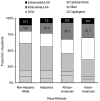Impact of metabolic syndrome on distribution of cervicocephalic atherosclerosis: data from a diverse race-ethnic group
- PMID: 19398114
- PMCID: PMC2721913
- DOI: 10.1016/j.jns.2009.03.033
Impact of metabolic syndrome on distribution of cervicocephalic atherosclerosis: data from a diverse race-ethnic group
Abstract
Background: Vascular localization of symptomatic large artery atherosclerotic (LAA) stroke differs for unknown reasons by race-ethnicity. The metabolic syndrome (MetSD) is associated with higher atherosclerotic stroke risk and comprises abnormal risk factors that can vary by race. Thus, we investigated whether MetSD may contribute to race-ethnic differences in LAA stroke by examining the association of MetSD with symptomatic intra- and extracranial atherosclerosis among a diverse race-ethnic group.
Method: We analyzed data prospectively collected over a 4-year period on subjects with ischemic stroke/TIA. Independent vascular risk factor associations with intracranial and extracranial LAA vs. non-LAA mechanism were evaluated in two groups stratified by race-ethnicity; whites and non-whites (Hispanics, African-American, and Asian-American).
Results: 1167 patients met study criteria. Intracranial LAA was more prevalent in non-whites vs. whites (20.4% vs. 9.6%, P<0.001), while extracranial LAA had a more frequent point value in whites compared to non-whites (10.7% vs. 7.5%, P=0.267). The presence of MetSD was more prevalent in both intracranial and extracranial LAA group than in non-LAA group: no significant differences were observed in the prevalence of MetSD between intra vs. extracranial LAA or whites vs. non-whites. However, with increasing numbers of abnormal metabolic components, whites were more likely to have experienced extracranial LAA, whereas non-whites were more likely to have experienced intracranial LAA. After adjusting for covariates, MetSD was associated with extracranial LAA in whites (OR, 1.98; 95% CI, 1.13-3.45), while there was a tendency that intracranial LAA was associated with MetSD in non-whites (OR, 1.80; 95% CI, 0.97-3.32). No association was found between MetSD and extracranial LAA in non-whites and between this syndrome with intracranial LAA in whites.
Conclusions: Our results showed that the impact of MetSD on the distribution of cervicocephalic atherosclerosis differed by race-ethnicity. This finding may in part explain the well-known differences in race-ethnic predilection to intracranial or extracranial atherosclerosis.
Figures
References
-
- Girman CJ, Rhodes T, Mercuri M, Pyorala K, Kjekshus J, Pedersen TR, et al. The metabolic syndrome and risk of major coronary events in the Scandinavian Simvastatin Survival Study (4 s) and the Air Force/Texas Coronary Atherosclerosis Prevention Study (AFCAPS/TEXCAPS) Am J Cardiol. 2004;93:136–41. - PubMed
-
- Expert panel on detection, evaluation, and treatment of high blood cholesterol in adults Executive summary of the third report of the National Cholesterol Education Program (NCEP) expert panel on detection, evaluation, and treatment of high blood cholesterol in adults (Adult Treatment Panel III) JAMA. 2001;285:2486–97. - PubMed
-
- Ovbiagele B, Saver JL, Fredieu A, Suzuki S, McNair N, Dandekar A, et al. Protect: A coordinated stroke treatment program to prevent recurrent thromboembolic events. Neurology. 2004;63:1217–22. - PubMed
-
- Smaha LA. The American Heart Association Get with the Guidelines Program. Am Heart J. 2004;148:S46–48. - PubMed
-
- Lee LJ, Kidwell CS, Alger J, Starkman S, Saver JL. Impact on stroke subtype diagnosis of early diffusion-weighted magnetic resonance imaging and magnetic resonance angiography. Stroke. 2000;31:1081–9. - PubMed
Publication types
MeSH terms
Grants and funding
LinkOut - more resources
Full Text Sources
Medical
Miscellaneous



